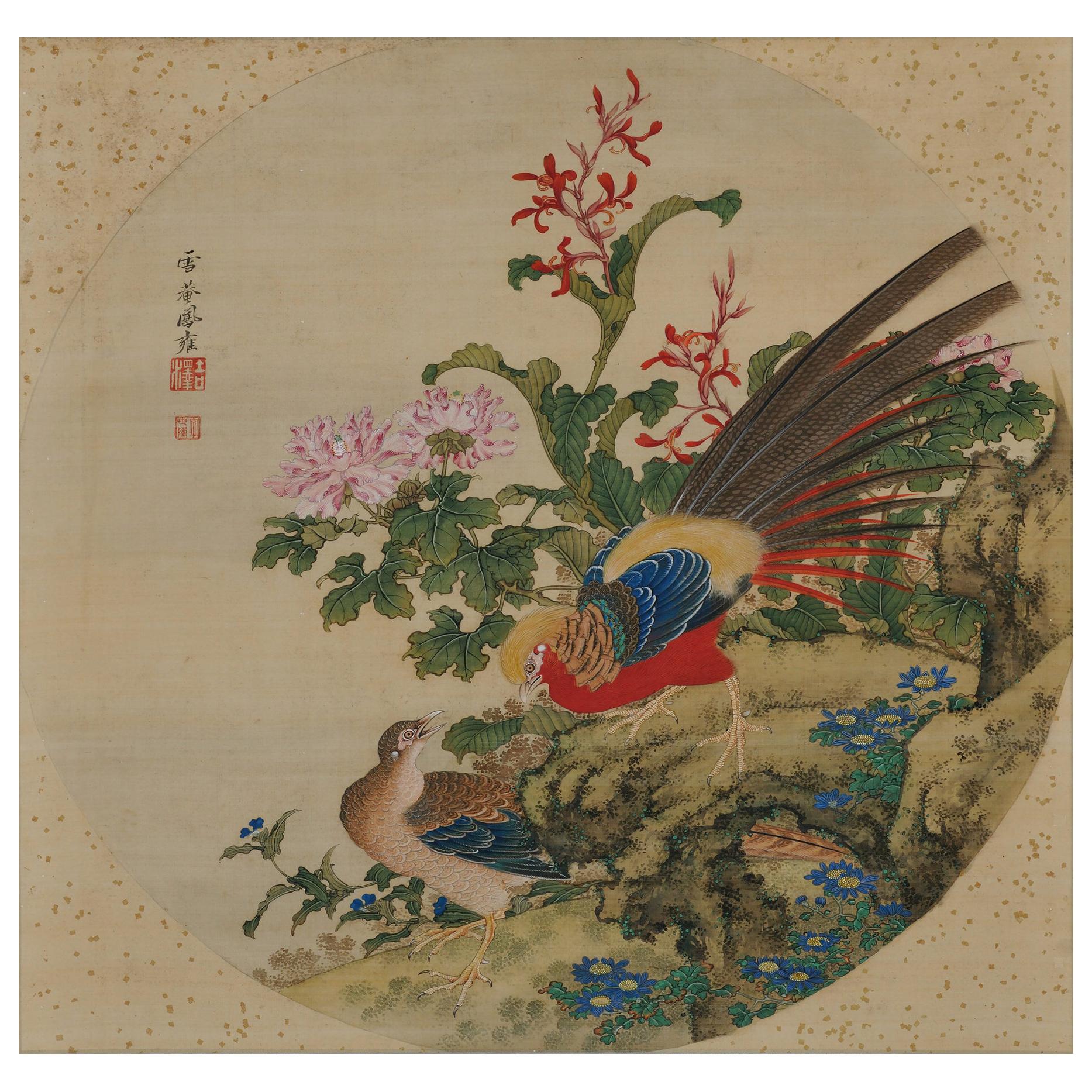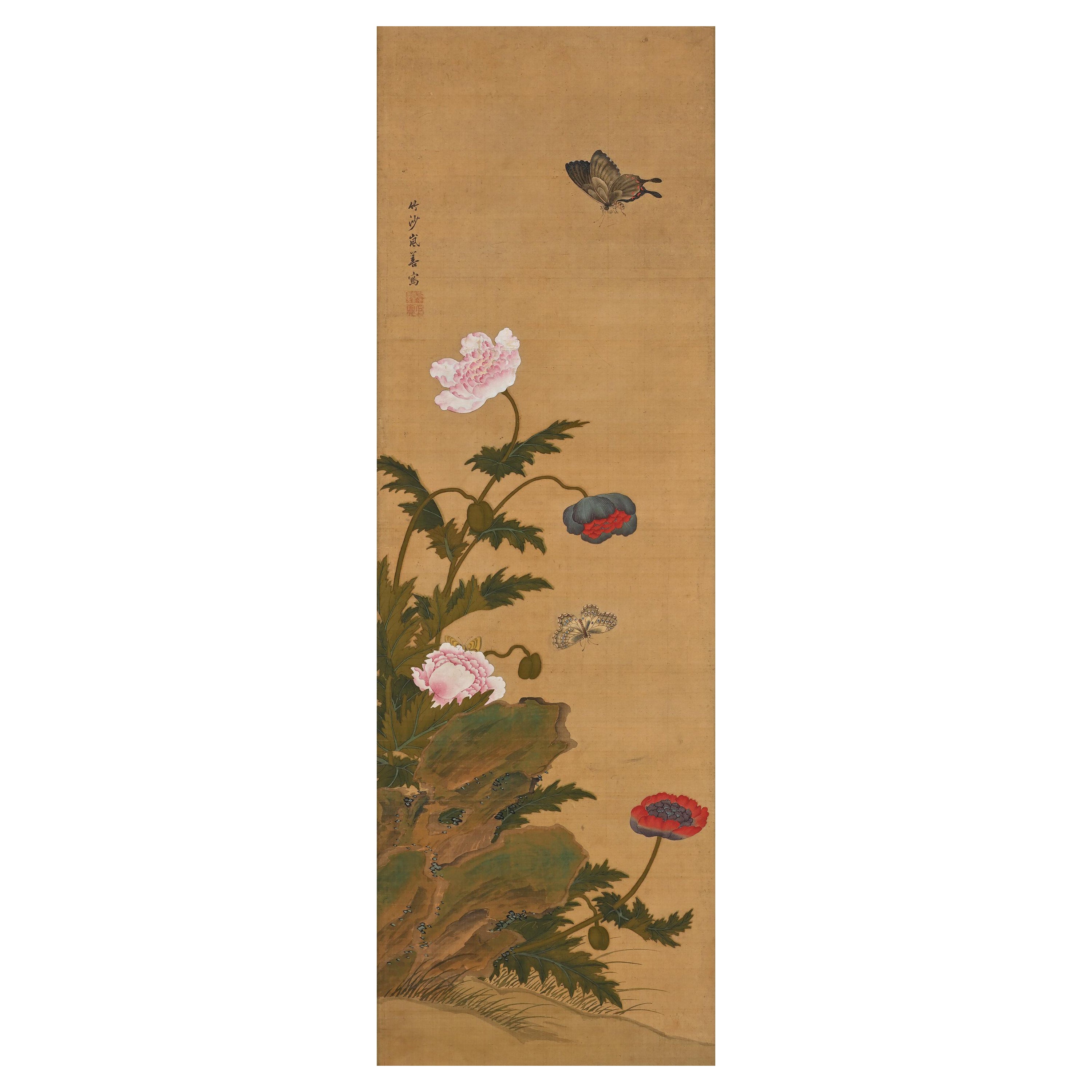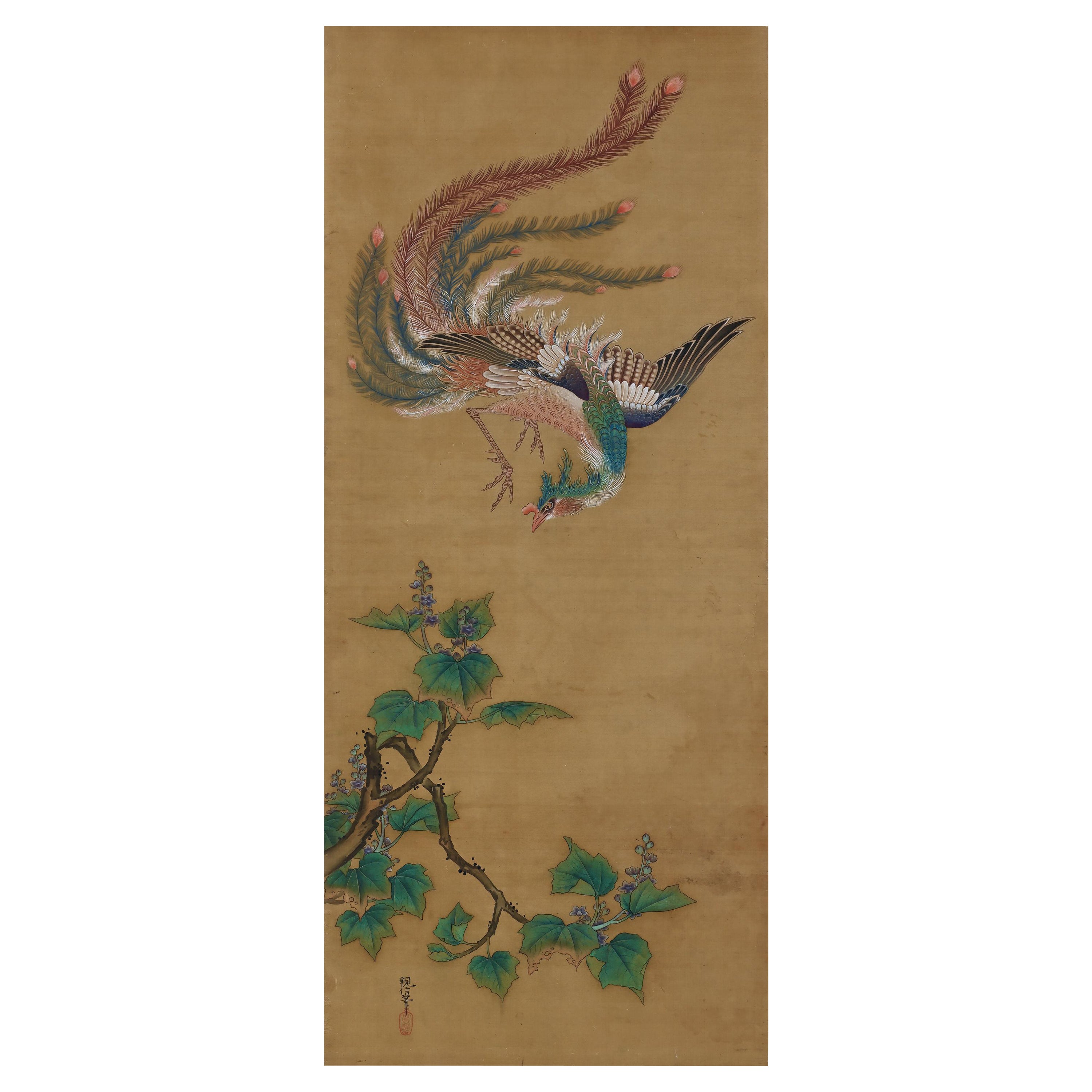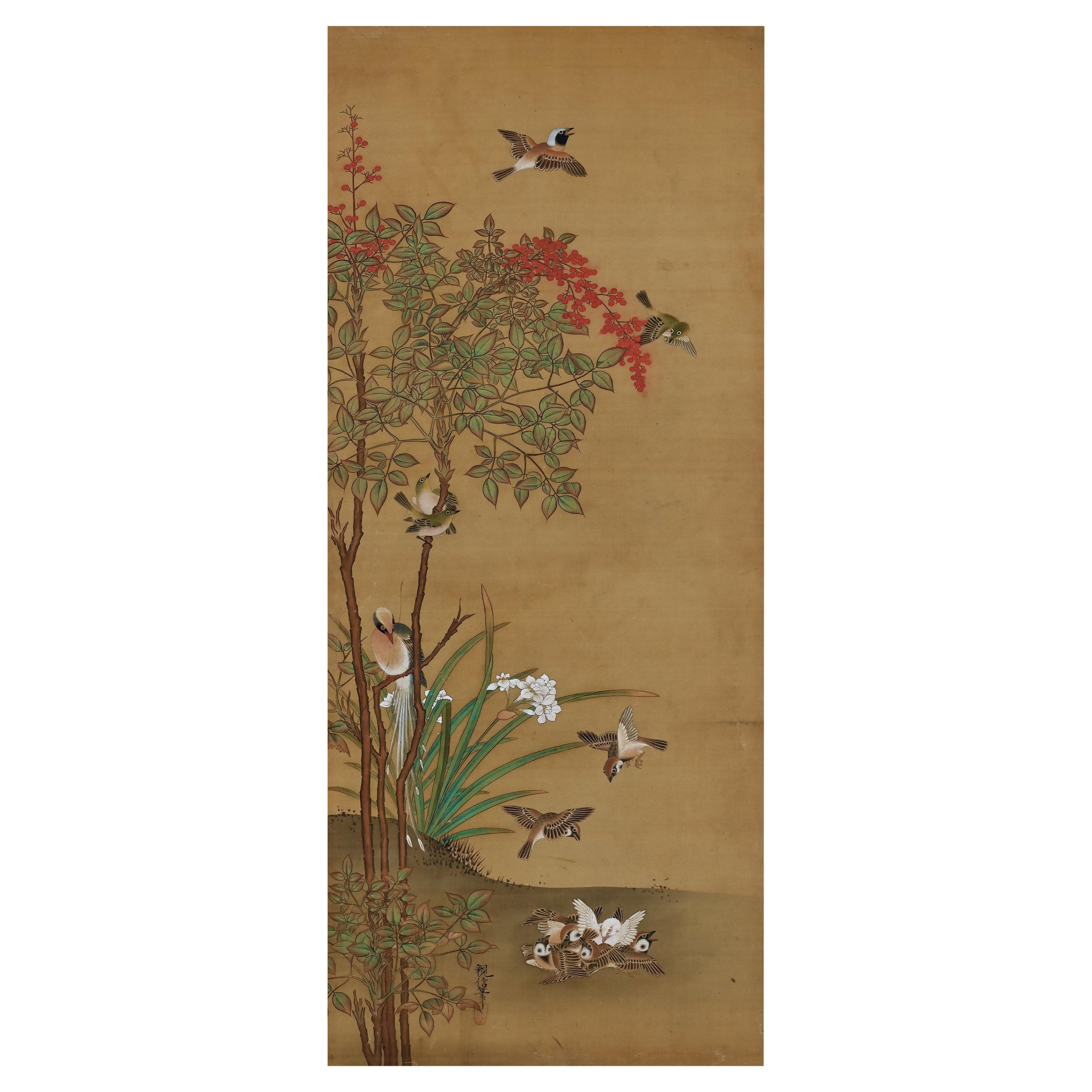Items Similar to Japanese Antique Ink Painting / 19th Century / Rare Chinese Character Painting
Want more images or videos?
Request additional images or videos from the seller
1 of 17
Japanese Antique Ink Painting / 19th Century / Rare Chinese Character Painting
About the Item
We have a unique Japanese aesthetic sense.
And only we can introduce unique items through our purchasing channels in Japan and the experience we have gained so far, in such a way that no one else can imitate.
It is an ink painting written after the Meiji era.
The biggest attraction of this work is that it uses Chinese characters to create paintings.
To explain in detail, it is written here in Chinese characters as "un-ryu" .
"Un" is a cloud and "ryu" is a dragon.
These are embodied and drawn by comparing them to the meaning of Chinese characters.
And the clouds depict the clouds hanging over the mountain, and the dragon depicts the climbing toward the mountain.
Humorous paintings using this Chinese character have been drawn in China, South Korea, and Japan for a long time.
The number that exists is by no means large.
This is one of the precious works.
I framed this paper with an acrylic board.
The surface of the acrylic plate has low reflection specifications.
Please attach it to the wall and decorate it.
There are few stores that sell such things in 1st dibs.
We sell with confidence.
Also, I want many people to know the goodness of antiques, so the price is set reasonably.
Why don't you show off to your friends around you?
Weight: 3.8 kg.
- Dimensions:Height: 40.75 in (103.5 cm)Width: 15.56 in (39.5 cm)Depth: 0.32 in (8 mm)
- Style:Edo (Of the Period)
- Materials and Techniques:
- Place of Origin:
- Period:
- Date of Manufacture:19th Century
- Condition:
- Seller Location:Sammu-shi, JP
- Reference Number:1stDibs: LU5487228471042
About the Seller
5.0
Platinum Seller
These expertly vetted sellers are 1stDibs' most experienced sellers and are rated highest by our customers.
Established in 2015
1stDibs seller since 2020
1,104 sales on 1stDibs
Typical response time: 5 hours
- ShippingRetrieving quote...Ships From: senzoku, Japan
- Return PolicyA return for this item may be initiated within 7 days of delivery.
More From This SellerView All
- Antique hanging scroll of Japanese cat/Late Edo-Meiji period/Cat paintingLocated in Sammu-shi, ChibaThis is a picture of a cat drawn by a person named "Toshizumi Nitta" from the end of the Edo period to the beginning of the Meiji period. She is a very simple and cute cat. He is a vassal of the Tokugawa Shogunate, born in Ota City, Gunma Prefecture (southern part of Gunma Prefecture). He was related to the Tokugawa family and lived in a large mansion in the Ota clan in Gunma prefecture. However, the Nitta family's territory was very small, and they were by no means a wealthy vassal. He seems to have lived quite poorly. So he painted cats and sold them to people. The Nitta family continued to draw pictures of this cat for four generations. "Nitta toshizumi" is equivalent to the fourth generation. During the Edo period, sericulture was thriving in the Kanto region. Cats were said to be the gods of silkworms, as they drive away mice, the natural enemies of silkworms. It was the Nitta family who drew such a cat on paper, pasted it in the silkworm chamber, and sold it as a mouse repellent. There were also other monks who painted pictures of cats, but the Nitta family in particular was related to the Tokugawa family, so people believed that paintings of cats had special powers. , a lot of paintings...Category
Antique Late 19th Century Japanese Edo Paintings
MaterialsPaper
- Japanese antique sketch scroll / 1800-1900 / Flower, bird and animal paintingsLocated in Sammu-shi, ChibaThis is a rough sketch of a Japanese painting drawn around the late Edo period to the early Meiji period (1800-1900) in Japan. A picture is drawn by sticking and connecting short pi...Category
Antique 19th Century Japanese Edo Paintings and Screens
MaterialsPaper
- Japanese Old Crane Painting / Picture Frame / 1900s-1930s / Picture of Two CraneLocated in Sammu-shi, ChibaIt is a framed picture of two cranes used in the space between the columns in the Meiji era. The frame is made of chestnut and the color is like lacquer....Category
Antique Early 19th Century Japanese Japonisme Decorative Art
MaterialsPaper
- Japanese small wooden temple tower/19th-20th century/"Hourin" temple/rare objectLocated in Sammu-shi, ChibaI have received an interesting item, so I would like to introduce it to you. This is a small wooden tower named "Hyakuman-To-Darani". This small wooden pagoda is a temple ornament us...Category
Antique 19th Century Japanese Edo Sculptures and Carvings
MaterialsCypress
- Japanese antique small Jizo stone Buddha/18th-19th century/Edo periodLocated in Sammu-shi, ChibaThis is a small stone Buddha made during the Edo period in Japan. His dignity is "Jizo Bodhisattva". She has a cute figure and a gentle face. It also depicts a lotus flower, with bo...Category
Antique 18th Century Japanese Edo Sculptures and Carvings
MaterialsStone
- Japanese Antique 19th Century Small Pottery Vase / Wabi Sabi Flower VaseLocated in Sammu-shi, ChibaThis is a very old Japanese pottery jar. It dates from the Meiji period (1800s-1860s). It is thought to have been used to extinguish charcoal fires. The darkening is due to soot fr...Category
Antique 19th Century Japanese Edo Vases
MaterialsPottery
You May Also Like
- Japanese Painting, Hanging Scroll, 19th Century Bamboo in MoonlightLocated in Kyoto, JPBamboo in moonlight Gamo Rakan (1784-1866) Hanging scroll, ink on silk. Dimensions: Scroll: 201 cm x 58 cm Image: 137 cm x 45 cm In this early 19th century work by Gamo Rakan a light ink wash applied to the silk background silhouettes the moon and suggests the atmosphere of early evening. Even though it is a literati subject, Rakan’s bamboo is quite realistic with a strong decorative style. The painting finds its inspiration from Chinese Ming dynasty painters who often used a single-tone, jet black stroke to emphasize the calligraphic nature of bamboo. In a different era, decorative would have been seen as somewhat unrefined. But increasingly in the Edo period, it was the hallmark of high style. The Japanese people, in particular the rising merchant class, had gradually become apathetic toward the traditional Sesshu and Kano schools of painting. Chinese professional and amateur painters living in the port of Nagasaki during the 18th century had a profound effect on Japanese painting and the freshness of their style and its decorative appeal contributed greatly to its popularity. Gamo Rakan’s teacher, Tani Buncho...Category
Antique Early 19th Century Japanese Edo Paintings and Screens
MaterialsSilk
- Japanese Scroll Painting, 19th Century Chinese Pheasants by Yoshizawa SetsuanLocated in Kyoto, JPChinese Pheasants Yoshizawa Setsuan (1809-1889) Hanging scroll, ink and color on silk. Painting inscription: Setsuan Houyou Upper seal: Y...Category
Antique Mid-19th Century Asian Meiji Paintings and Screens
MaterialsSilk
- 19th Century Japanese Scroll Painting by Igarashi Chikusa, Poppies & ButterfliesLocated in Kyoto, JPPoppies & Butterflies Ink, pigment and gofun on silk Igarashi Chikusa (1774-1844) Signature: Chikusa Ran Zen Upper Seal: Ran Shuzen Lower Seal: Kyoho Dimensions: Scroll: H. 68” x W. 18” (172cm x 45cm) Image: H. 38.5’’ x W. 12.5’’ (98cm x 32cm) This composition shows elegant images of poppies and the butterflies that are inevitably drawn to them. It captures a momentary glimpse into a world both visually dazzling and startlingly realistic. The painting is infused with sensitivity and attention to seasonal change and weather conditions. The thin and fragile poppies are beautifully depicted with brilliant colors and the butterflies are similarly infused with life. The painting is on silk which requires extremely precise painting skills as no element once painted can be removed. Poppies were a favorite subject of Rinpa school artists through the ages. Originally they were somewhat abstracted but by the age of Sakai Hoitsu...Category
Antique Early 19th Century Japanese Edo Paintings and Screens
MaterialsSilk
- 19th Century Japanese Silk Painting by Kano Chikanobu, Phoenix & PaulowniaLocated in Kyoto, JPBirds & Flowers of the seasons Pheasants & Plum in Snow Unframed painting. Ink, pigment and gofun on silk Kano Chikanobu 1819-1888 Signature...Category
Antique Mid-19th Century Asian Edo Paintings and Screens
MaterialsSilk
- 19th Century Japanese Silk Painting by Kano Chikanobu, Turtles & AzaleaLocated in Kyoto, JPBirds & flowers of the seasons Pheasants & plum in snow Unframed painting. Ink, pigment and gofun on silk Kano Chikanobu 1819-1888 Signature...Category
Antique Mid-19th Century Asian Edo Paintings and Screens
MaterialsSilk
- 19th Century Japanese Silk Painting by Kano Chikanobu, Sparrows & NandinaLocated in Kyoto, JPBirds & flowers of the seasons Pheasants & plum in snow Unframed painting. Ink, pigment and gofun on silk Kano Chikanobu 1819-1888 Signature...Category
Antique Mid-19th Century Asian Edo Paintings and Screens
MaterialsSilk
Recently Viewed
View AllMore Ways To Browse
Wall Hanging People
Antique Paintings Of People
Japanese Antique Painted China
Korean 19th
19th Century Korean
Late 19th Century Japanese Plates
Wall Hanging Japan
Framed China Plate
Meiji China
Antique Japanese China Set
Japanese Wall Decorate
Antique Ink Sets
Korea Antique Furniture
Korean Antiques
Edo Frames
Japanese Chinese Dragons
Japanese Meiji Plates
Antique Wall Hanging Plates





